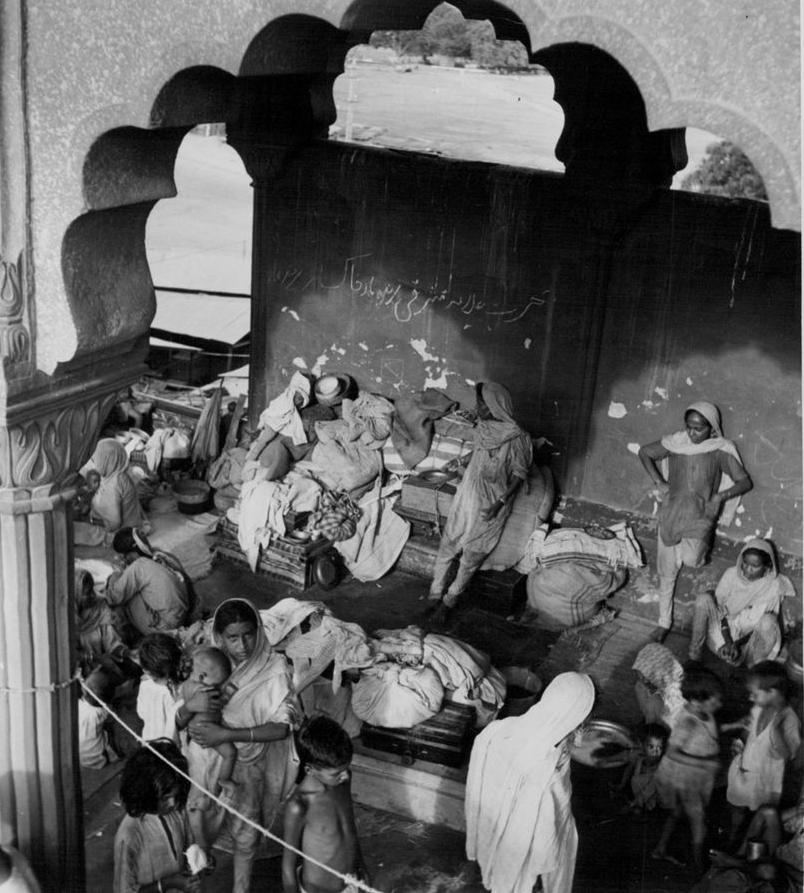
Indian and Pakistani Partition: Population Movement (1947-48)

Figure 1.--As violence flared with partition, Muslins in the north often souhjt afety in Mosques. The press caption here read, Moslems seek safety in Mosque: Delhi's Juma Mosque, one of the world's most beautiful temples, today teems with frightened, bewildered humanity as thousands of Moslem refugees seek shelter and safety behind iss ancient walls. Hungary dirty and weary. the refugees huddle together in corridors and alcoves off the main floor, eatinf, sleeping and waiting for transportation to Pakistan in a few squalid feet of space. A group of refugees. ranging in age from infants to ancients, are shown in the photo ...." Photographer: Bert Brandt. The photograph was taken Septenber 25, 1947.
|
|
Congress eventually acceoted a partition plan. No one, however, expected a large population movements. The officials involved could not have been more wrong. Independence and the coomunal rioting that ensued set in motion some 14.5 million people seeking safety in an increasingly chaotivc amd lawless communities. The British were gone, the ne. And the new Indian Goverment was completely unpreapred and illequipped to dael with an una nticipated security crisis--the largest mass migration in human istory involving increasingly histile communities. Destitute Muslims fled from India and Hindus and Sikhs from Pakistan as vicious riots and communal rampages forced people from their homes. These were terrified, for the most part impoverished people, forced from their ancestral homes. Partition set in motion the largest mass migration in history. Some 10-13 million people were set in motion--most of it on foot. These people including children and the elderly fled across the sudenly delineated borders. Many had to move long distnces on foot without any humamitarian support such as feeding stations or sanitary and medical facilities. It was beyond the capability of the security forces to contol. Thousands more died in violence as these collumns passing each other in opposite directions along major roads. And as they foraged for food and were set upon by villagers also inflamed by religious and national zealotry as well as protcting their fields. The numbers do not begin to describe the human tragedy and suffering experienced by these people. The physical savagery was inconceivable. One of the refugees provides the terrifying human perspective, "Now before our yyes lie dried tracks of blood, cut up human parts, charred faces, mangled necks, terrified people, looted houses, burned fields, mountains of rubble, and overflowing hospitals. We are free. Hindustan {India} is free. Pakistan is free, and we are walking the desolate streets naked without any possessions in utter distress." [Manto]
Sources
Manto, Saadat Hasan. Manto (1912-1955) was a popular Urdu short story writer and a rising screenwriter in Bombay at the time of Partition (1947). He is best known for the short stories he wrote after migrating to Lahore in the new state of Pakistan. No other author captured the emotions and experiebces with such force as Manto.
CIH

Navigate the Children in History Website:
[Return to Main Indian independence and partition--Inter-communal violence page]
[Return to Main Indian independence and partition page]
[Return to Main Indian history page]
[Return to Main Pakistani history page]
[Return to Main Indian-Pakistani conflict page]
[Return to Main 20th century page]
[Introduction]
[Biographies]
[Chronology]
[Climatology]
[Clothing]
[Disease and Health]
[Economics]
[Geography]
[History]
[Human Nature]
[Law]
[Nationalism]
[Presidents]
[Religion]
[Royalty]
[Science]
[Social Class]
[Bibliographies]
[Contributions]
[FAQs]
[Glossaries]
[Images]
[Links]
[Registration]
[Tools]
[Children in History Home]
Created: 1:50 PM 7/19/2015
Last updated: 1:51 PM 7/19/2015



